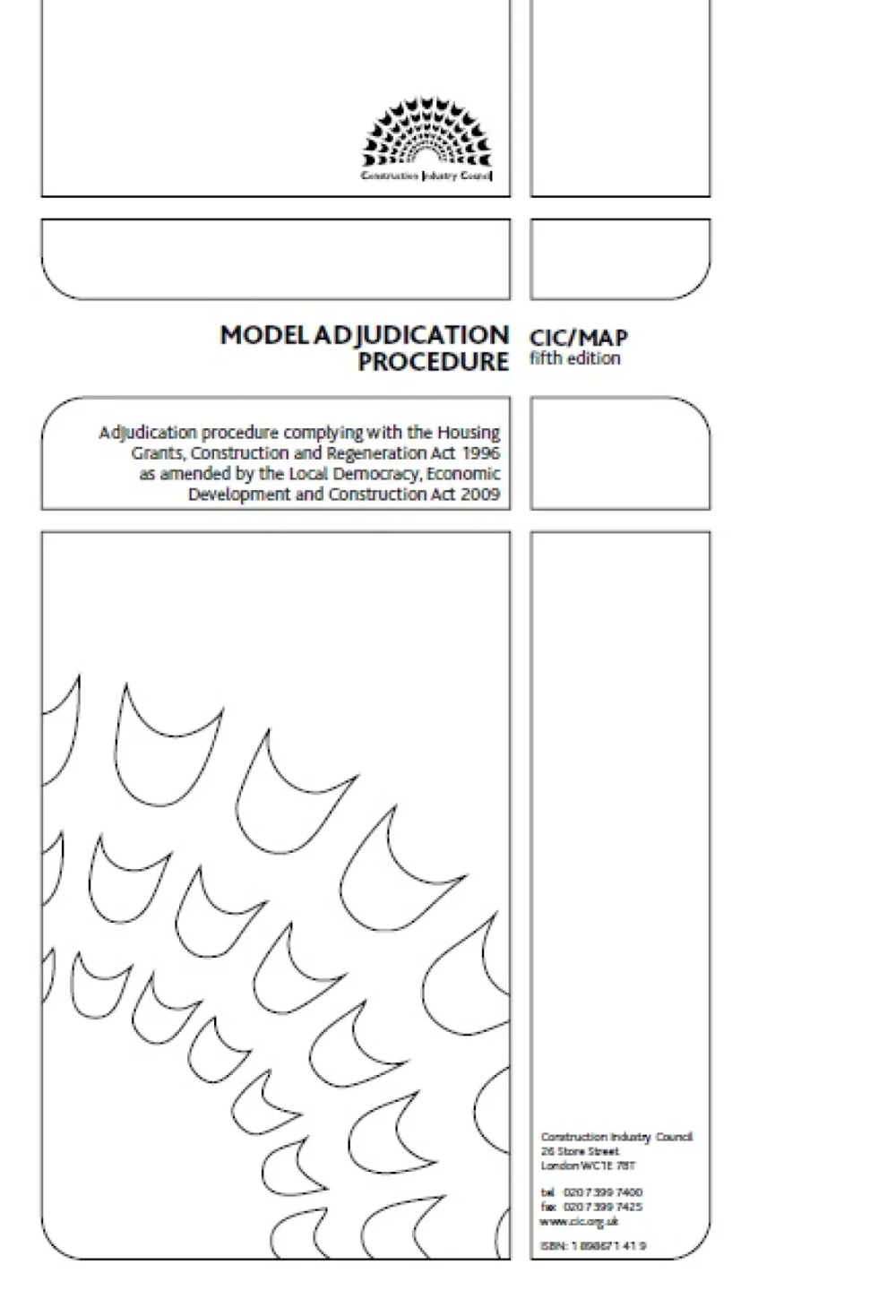Model Adjudication Procedure MAP
The Model Adjudication Procedure (MAP) is published by the Construction Industry Council (CIC) and currently in its fifth edition. It is a contractual adjudication procedure compliant with the Housing Grants, Construction and Regeneration Act 1996 incorporating the amendments made by the Local Democracy, Economic Development and Construction Act 2009. The procedure can be incorporated by reference into a contract or used by agreement of the parties; it is accompanied by a model adjudication agreement. For further information visit: https://www.cic.org.uk/shop/model-adjudication-procedure-fifth-edition-pdf-only
The CIC Model Adjudication Procedure (CIC LVD MAP) sets out a streamlined adjudication procedure for Low Value Disputes, and, by linking the Adjudicator’s fee to the amount claimed, provides certainty as to how much the Adjudicator will be paid for making an Adjudicator’s Decision. By including an outline timetable for the procedural stages it provides a flexible yet simple to understand approach to the key elements of the adjudication process.
The CIC LVD MAP can be adopted if the Parties have incorporated it into the Contract by reference, the reference shall be deemed to be to the edition current at the date of the Notice of Adjudication, unless expressly stated otherwise in the Contract. Alternatively, the Parties may agree to use the procedure on an ad-hoc basis when a dispute arises.
The existing CIC MAP Edition 5 (CIC LVD MAP) was approved by the CIC Business Panel in November 2019 and published on 1 May 2020, in light of the amendments to the Construction Act 1996. The CIC LVD MAP has been embraced by the UK construction industry, with about 800 adjudicator appointments from 1 May 2020 to the end of March 2025.
The MAP is a contractual adjudication procedure compliant with the Housing Grants, Construction and Regeneration Act1996 incorporating the amendments made by the Local Democracy, Economic Development and Construction Act 2009. The procedure can be incorporated by reference into a contract or used by agreement of the parties; it is accompanied by a model adjudication agreement.
The amendments to the Construction Act came into effect on 1 October 2011 in England and Wales (1 November 2011 in Scotland) and affect everyone in business involved in construction work. All construction contracts which are entered into on or after 1 October 2011 must comply with the provisions of the amended Construction Act. In practical terms this will mean that all projects currently at the tender stage will be subject to the new provisions.
For further guidance see the CIC USERS’ GUIDE TO ADJUDICATION published in 2017
[edit] Related articles on Designing Buildings
- Adjudicator.
- Adjudicator Nominating Body ANB.
- Adjudication.
- Adjudicators and bias.
- Alternative dispute resolution.
- Alternative Dispute Resolution legislation.
- Arbitration.
- Arbitration v Adjudication.
- Breach of contract.
- Causes of construction disputes.
- Conciliation
- Contract claims.
- Contract conditions.
- Dispute resolution.
- Dispute resolution board.
- Expert determination.
- How does arbitration work?
- Joinder.
- Low Value Disputes Adjudication.
- Low Value Disputes Model Adjudication Procedure.
- Low Value Disputes Procedure LVDP.
- Mediation.
- Pay now argue later.
- Pendulum arbitration.
- PFIs and adjudication.
- The Housing Grants, Construction and Regeneration Act.
- The role of the mediator.
- The Scheme for Construction Contracts.
Featured articles and news
RTPI leader to become new CIOB Chief Executive Officer
Dr Victoria Hills MRTPI, FICE to take over after Caroline Gumble’s departure.
Social and affordable housing, a long term plan for delivery
The “Delivering a Decade of Renewal for Social and Affordable Housing” strategy sets out future path.
A change to adoptive architecture
Effects of global weather warming on architectural detailing, material choice and human interaction.
The proposed publicly owned and backed subsidiary of Homes England, to facilitate new homes.
How big is the problem and what can we do to mitigate the effects?
Overheating guidance and tools for building designers
A number of cool guides to help with the heat.
The UK's Modern Industrial Strategy: A 10 year plan
Previous consultation criticism, current key elements and general support with some persisting reservations.
Building Safety Regulator reforms
New roles, new staff and a new fast track service pave the way for a single construction regulator.
Architectural Technologist CPDs and Communications
CIAT CPD… and how you can do it!
Cooling centres and cool spaces
Managing extreme heat in cities by directing the public to places for heat stress relief and water sources.
Winter gardens: A brief history and warm variations
Extending the season with glass in different forms and terms.
Restoring Great Yarmouth's Winter Gardens
Transforming one of the least sustainable constructions imaginable.
Construction Skills Mission Board launch sector drive
Newly formed government and industry collaboration set strategy for recruiting an additional 100,000 construction workers a year.
New Architects Code comes into effect in September 2025
ARB Architects Code of Conduct and Practice available with ongoing consultation regarding guidance.
Welsh Skills Body (Medr) launches ambitious plan
The new skills body brings together funding and regulation of tertiary education and research for the devolved nation.
Paul Gandy FCIOB announced as next CIOB President
Former Tilbury Douglas CEO takes helm.
UK Infrastructure: A 10 Year Strategy. In brief with reactions
With the National Infrastructure and Service Transformation Authority (NISTA).























